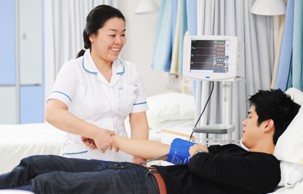7. Phase I Clinical Studies - Proof of Mechanism
Step 7. Phase I Clinical Studies - Proof of Mechanism
The decision to start the first clinical study is a major one. As a candidate compound continues through the development process, the number, the cost and the complexity of the activities all increase.
Before starting a clinical study, a Clinical Trial Application (CTA) must be submitted to the National Competent Authority (NCA) (the regulatory authority in the country where the trial is planned to take place) for approval. The application must include the following important documents:
- A cover letter and the clinical trial application form.
- An Investigational Medicinal Product Dossier (IMPD), including ADME and studies to observe effect (on the target), the toxicology safety, and information on how the medicine is manufactured.
- The Study Protocol describing the details of performing the study and evaluating the results (including a detailed description of the recruitment and informed consent procedure, especially when participants are incapable of giving informed consent (cf. Article 6(3)(k) of Directive 2001/20/EC)).
- The Investigator’s Brochure (IB), providing a summary of the information that allows the doctors who run the study (the investigators) to understand how the study medicine works in the body (the pharmacology). This allows the investigators to explain the study to the volunteer or patient and to obtain informed consent (see below).
During the process, an opinion
from the relevant Ethics Committee must also be obtained. The Ethics Committee
is an independent group, usually consisting of doctors, scientists, nurses, and
non-experts (‘lay’ members). They review, among other things, the Study
Protocol (especially the informed consent form) and ensure that they comply
with the ethical principles of research involving humans.
Safety is the top priority; hence, a study in humans cannot start until the Internal Company Review Committee, an External Ethics Committee and the respective Regulatory Authority have given their opinion and approval.
Phase I Study - (also called Volunteer Study, Exploratory Study, Proof of Mechanism study or First in Human Study)
This study allows the doctors and scientists to see if the medicine is safe in humans. It also looks at whether the medicine behaves in humans in the same way that it behaved in animals. These studies provide information on the way that the medicine works – called the ‘mechanism of action’. These studies also aim to find any secondary effects of the medicine.
About 20 -100 volunteers are included in Phase I of the clinical trials. These trials are usually performed in special Phase I units where the volunteers are recruited and the trials are run. The doctors who carry out these trials are called investigators and they are qualified to conduct clinical trials.
The first clinical trial is usually carried out in healthy, male volunteers. The details of the clinical trial have to be described in the Study Protocol, this has to include:
- The background of the disease (the unmet need).
- The non-clinical information.
- The details of the clinical trial (what exactly will be done and when).
- How the information will be used and analysed.
The Study Protocol also has a section on ‘statistics’ which describes the statistical tests to be used to analyse the results. These have to be decided before the clinical trial starts, so it is known how the information will be obtained and analysed once the trial ends.

Figure 7. Picture of Phase I volunteer study.
As safety is a priority, the
first clinical trial starts with a very low dose of the medicine:
- A single dose of the medicine is used for each volunteer.
- Once it has been shown that there are no safety concerns with this first dose, the trial can continue with a slightly higher dose.
- The dose will then be further increased (‘ascending dose’) until the maximum dose allowed for the trial has been reached.
This is described in the Study
Protocol.
The trial results can then be
analysed and all the safety measurements can be assessed. This includes the:
- Pharmacokinetics – what the body does to the medicine. The blood levels of the medicine can be measured – to determine the Absorption, Distribution, Metabolism and Excretion (ADME – see also non-clinical studies earlier).
- Pharmacodynamics – what the medicine does to the body (the ‘effect’). For example, measurement of the effect of a medicine on certain blood cells.
This type of trial is known as a Single Ascending Dose (SAD) trial. This is usually followed by a Multiple Ascending Dose (MAD) trial which, as the name suggests, involves multiple doses per volunteer.
Apart from the SAD and MAD studies, other Phase I studies are also needed. For example: to look at the effect of food or to look at the effect of other medicines given at the same time.